Menus
- Ducati against Suzuki, Kawasaki, Honda and BMW
- Ducati versus Suzuki
- Ducati versus Honda
- Ducati versus BMW
- MOTORCYCLE test result
- Prices and offers of current sports tourers in Germany

factstudio.de
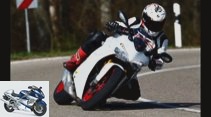
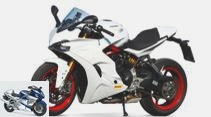
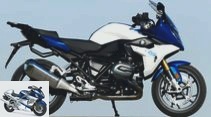
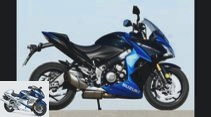
29 photos
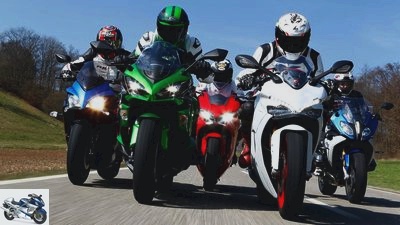
1/29
One against all. Ducati SuperSport S in comparison test with Suzuki GSX-S 1000 F, Kawasaki Z 1000 SX, Honda VFR 800 F and BMW R 1200 RS

2/29
Ducati SuperSport S in comparison test.
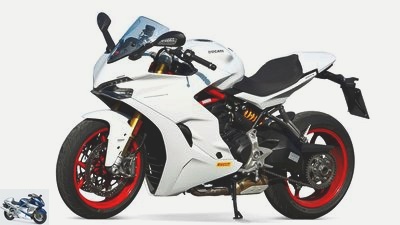
3/29
Ducati’s new entry into the all-rounder segment uses a modular system: the Hypermotard drive as a supporting element, tubular space frame, Panigale-inspired design language. Not a disguised naked bike, but a specially constructed sports tourer – even if Ducati doesn’t want to call it that.
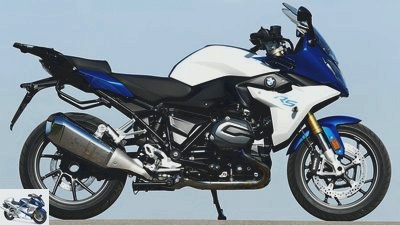
4/29
The BMW R 1200 RS is based on the already lavishly equipped Roadster R 1200 R..

5/29
Suzuki’s entry into the segment is also a (rather cautiously) modified naked bike.
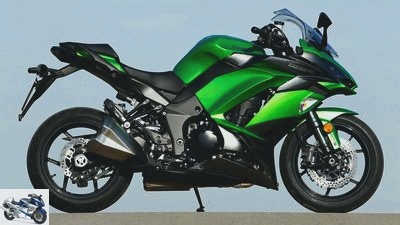
6/29
Based on the Z 1000, the SX fairing has much more space and features.
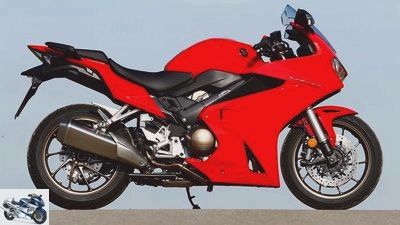
7/29
Original: The grandmother of the VFR 800 defined the segment more than 30 years ago.
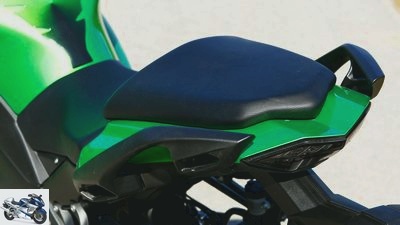
8/29
The good compromise: the space available at the rear of the Kawasaki is not exaggeratedly expansive, but it is definitely enough for a weekend trip. The case holders have been integrated very elegantly.
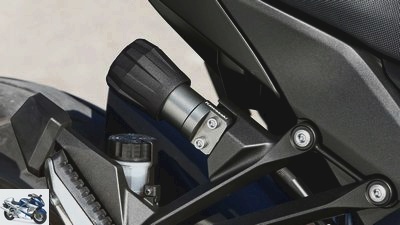
9/29
The preload of the shock absorber can then be easily adjusted using a practical handwheel.
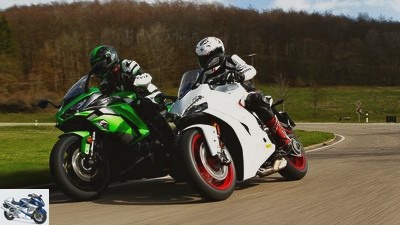
10/29
Kawasaki Z 1000 SX. Poison green, evil and excellently equipped, the Nippon foursome takes on the desmo challenge in innocent white

11/29
Ducati SuperSport S: You won’t find a handwheel on the directly hinged Ohlins damper. The Duc has other strengths.
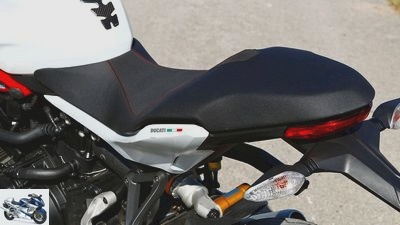
fact
12/29
Ducati SuperSport S: Compromise, but based on the athlete philosophy: Under the stylish cover there is a pillion seat suitable for day trips. Both cushions are narrower and tighter than the Kawa, but sufficiently large and comfortable.
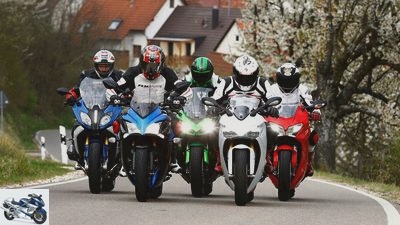
13/29
One against all. Ducati SuperSport S in comparison test with Suzuki GSX-S 1000 F, Kawasaki Z 1000 SX, Honda VFR 800 F and BMW R 1200 RS
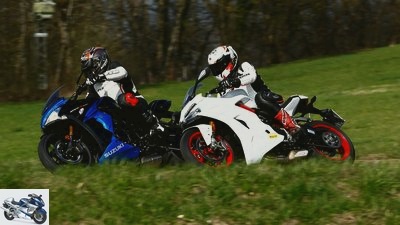
14/29
Suzuki GSX-S 1000 F in comparison test.
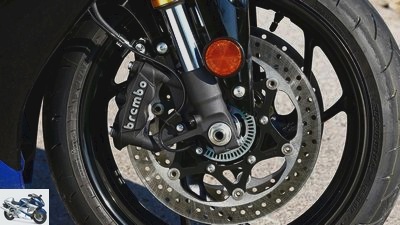
15/29
Radially struck brembos at the front delay a little bluntly at first. The fork is sporty and taut.
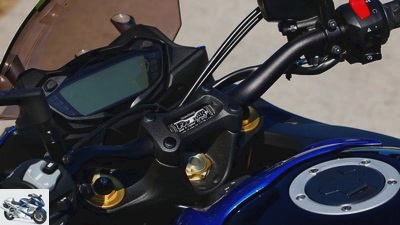
16/29
The fact that the Suzuki is actually a power-naked with fairing is particularly evident from the only superbike handlebar. This requires an upright, but broadly aggressive sitting posture. Sufficient wind protection.
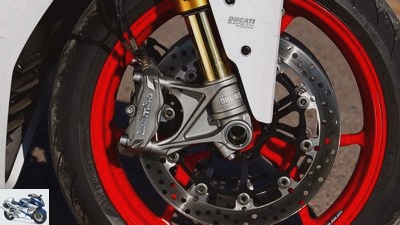
17/29
Ducati SuperSport S: There are also radial brembos on the SuperSport, but here they are noticeably crisper and more finely dosed.
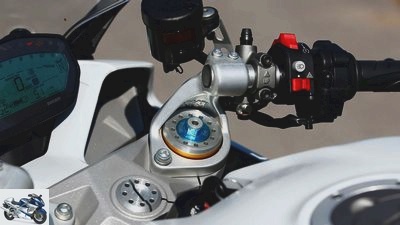
18/29
Ducati SuperSport S: The rather soft, sprung, coated fork also speaks well. The positioning of the handlebars – not too high, rather wide – in connection with the high seat cushion and the short tank shape is an absolute stroke of luck. Convenience and feedback!
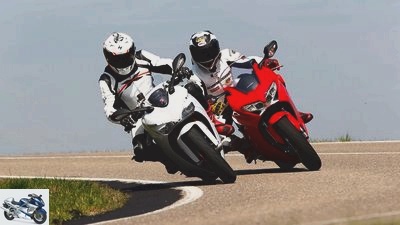
19/29
Honda VFR 800 90-degree V-engine, single-sided swing arm, athlete genes. Formally and visually similar.
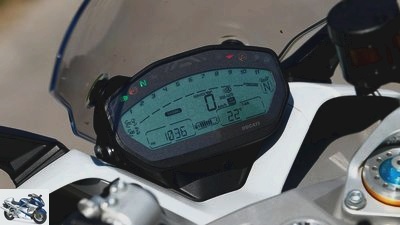
20/29
Ducati SuperSport S: The TFT cockpit is known from other Ducs. Readability and functionality are good, but the menu navigation is sometimes confusing, and some fonts are very small.
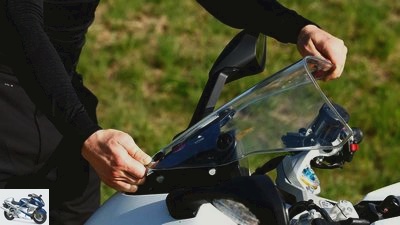
21/29
Ducati SuperSport S: The windshield is adjustable and works just well enough – as we understand it as an everyday athlete.
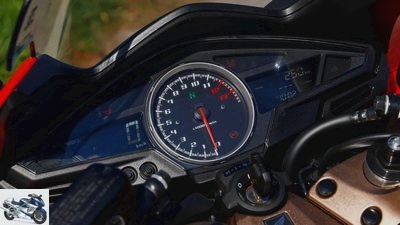
22/29
The Honda information center could also come from a Civic R. Huge, analog tachometer (V-Tec!), A bit old-fashioned, but high-contrast TFT display with a good range of functions. The switch for the TC (not in the picture) looks improvised.
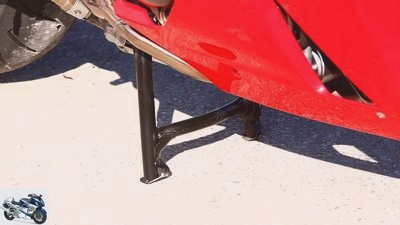
23/29
The main stand shows what the VFR 800 F is actually about: utility.
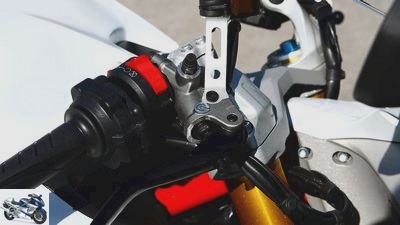
24/29
Ducati SuperSport S: The only radial brake pump in comparison: noble and, together with the Kawa, best controllability. In addition to the BMW, the Honda also offers a single-sided swing arm – but no other can keep up with the sound of the valve-controlled exhaust.
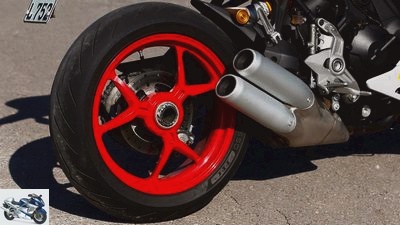
25/29
Ducati SuperSport S: cheeky rumbling, snotty bubbly and loud – as if there were no Euro 4.
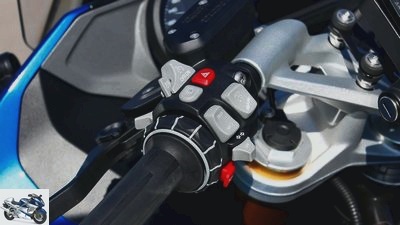
26/29
BMW R 1200 RS: The center of power: You probably already know this switch unit, it represents the extreme equipment and functional overkill of BMW. Cruise control, sat nav, ESA, BC etc. – everything can be operated from here.
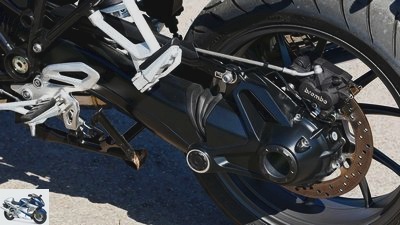
27/29
BMW R 1200 RS: As the only machine in the field, the RS has a cardan shaft, good for eating kilometers without having to maintain the chain. Drive reactions are barely noticeable, but the extra weight is.
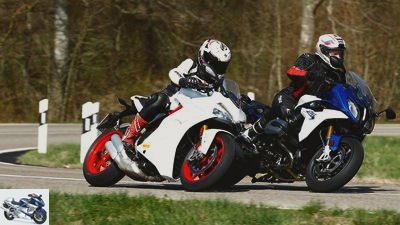
fact
28/29
BMW R 1200 RS in the comparison test.
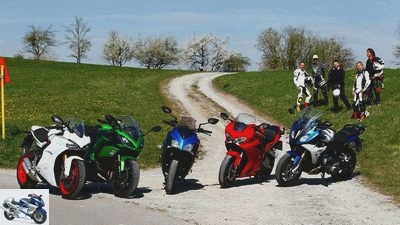
29/29
One against all. Ducati SuperSport S in comparison test with Suzuki GSX-S 1000 F, Kawasaki Z 1000 SX, Honda VFR 800 F and BMW R 1200 RS
Sports tourers in the comparison test
Ducati against Suzuki, Kawasaki, Honda and BMW
The Ducati SuperSport S throws the gauntlet down to the assembled sports tourer guild. Competing in the comparison test: Suzuki GSX-S 1000 F, Kawasaki Z 1000 SX, Honda VFR 800 F and BMW R 1200 RS.
Growth in the sports tourer segment, and it comes from Bologna! Even if D.ucati, like others, shies away from this not very hip term for the new series like a photo model does under armpit hair, but in the end the SuperSport has evidently become just that: a sports tourer. Where did the shyness come from? After all, this category embodies exactly what many are looking for: the real all-rounder, which ideally marks the golden mean between everyday and excursion skills and, well, a good helping of sport.
Buy complete article
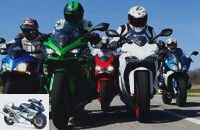
Sports tourers in the comparison test
Ducati against Suzuki, Kawasaki, Honda and BMW
Ducati versus Kawasaki
It starts with the Kawa, which at 13,720 euros test vehicle price (with suitcases) is closest to the 14,500 euros expensive Italian and which sits right in the middle of the field. The Z 1000 SX presents itself as an endurance athlete with its 142 PS in-line four-cylinder, great ergonomics and neat equipment (large 19-liter tank, adjustable windshield, IMU-controlled cornering ABS and lean angle-dependent traction control). In any case, the engine of the SuperSport almost necessarily has to give up, but the advantage of the Kawa is surprisingly small. The 1043 cubic inline four scores well with full acceleration, sinewy pulling power, fine responsiveness and, overall, a calm and confident engine characteristic that is ideally suited to the all-rounder. But the 937 cubic L-Twin from Bologna can do some things as well, some even better. There are two reasons for this. On the one hand, the well-known 937 in the SuperSport has reached its top form so far, for the first time avoiding the slight sag that basically plagues every Testastretta engine sometimes more, sometimes less. In the Ducati, the Desmo-Twin spans a textbook-like performance curve, free of dips, which is reflected in attractive driving performance. The unit is always present as a two-cylinder, but never annoying with unpleasant vibrations, on the contrary, runs wonderfully smoothly for a V-engine. With correct linear throttle response, lively (SPORT), accurate (TOURING) or restrained (URBAN) depending on the driving mode, the not-so-small L-Twin delivers robust pressure and, on top of that, fiery Italian revving and joie de vivre. Second, and this explains the great measured values, in contrast to the small Multistrada, it carries little weight in the filigree SuperSport. When I had trained 217 kilos, the editorial scale stopped, a good value. And you not only feel this lack of prosperous fat when you accelerate, but always. The Z 1000 SX, which weighs in at 236 kilograms, cannot stand out in terms of engine despite the significant increase in displacement, especially since it runs rather rough, as is typical for Kawa, tingles in higher speed ranges through the rubber-mounted footrests and thus plays a little feel-good character. For this, the Kawa offers a very smooth-running cable clutch and a fluffy gear of the type “Best Japanese mechanical engineering”.
But here, too, the SuperSport is hardly worse with an equally smooth hydraulic clutch and a precise but somewhat hard gearbox. But connoisseurs already suspect: This transmission also needs precisely defined inputs, otherwise there is a risk of idling and passenger malice. A Quickshifter, which the S version of the Duc carries as standard, can otherwise only be offered by BMW (at an additional cost). Clutchless upshifts and downshifts are excellent, the shift pauses are pleasantly short for a two-cylinder. Aside from the rather large jump between gear steps one and two, practically nothing jerks, whether under full load or at half throttle – the bottom line is that it tipped the scales to the motorized near stalemate to the Kawasaki Z 1000 SX.
In terms of ergonomics, too, the sporty Bolognese of the recognized good green all-purpose weapon sticks in the neck. Sitting upright on high handlebar risers, with a pleasantly open knee angle, behind a high, easily adjustable windshield – the Kawa driver will find a very suitable naked bike workplace that has been shifted far into the touristy. SuperSport approaches the topic from the opposite direction, namely as a comfortable athlete. Significantly higher, crisp and intimate seat hollow, slightly lower handlebars, footpegs that are not that low – this description would lead to bad fear, but on the Duc it can be endured for hours. The reason for this is the wonderfully narrow design and careful fine-tuning. You can literally merge with the machine. Thanks to the high upholstery, the knee angle is comfortable and taller drivers have enough space for their legs. Thanks to a compact design with a short but steep tank (which can take some of the driver’s weight if necessary), the Ducati engineers have managed to put almost no weight on the wrists despite the rather sporty arrangement – a real letter of recommendation.
The Ducati then dupes the Z 1000 SX when wagging around bends. The problem with the Kawa is not new: First of all, the SX steers extremely easily and directly (shortest wheelbase), literally falls into the curve by itself, and with a bit of getting used to, can be controlled intuitively with an impulse from the hip and the footrests. In the further course, however, the Z 1000 SX reacts overly sensitively and with a strong righting moment to bumps, but especially to braking in an inclined position. Then she literally blocks herself. The reason? Bridgestone’s S 20, which is good in itself, is designed in the special specification “N” with a stiff carcass that is too much designed for stable straight-line stability, which is and remains a shame. The Duc moves into the next round.
Ducati versus Suzuki
With a rather unfortunate specification of the first tires, however, Suzuki’s GSX-S 1000 has no problems, the Dunlop D214 “M” needs a little warming up, but then steers and adheres perfectly. In general, the Suzuki is so dedicated to the subject of sport that even the blues from Hamamatsu don’t hear anything from the “Tourer”, want their technically practically unchanged, disguised sister of the GSX-S 1000 to be understood as a country road athlete.
The seating position is special, but successful. The “F” looks compact with its low, wide superbike handlebars (the only one in the test field) and its rather wide tank at the same time as beefy. Comfortable in and of itself, apart from the rather spartan seat cushion. But it fits Suzuki’s claim, because she constantly conveys aggressiveness. The GSX-S 1000, whether naked or disguised, is the type of motorcycle on which you automatically extend your elbows, downshift one or two gears and charge. And that works very well, thanks on the one hand to the very low weight of 216 kilograms and on the other to the potent 999 cubic unit. The “F” bends with relish but reliably, dances quite neutrally through tight meandering, and takes alternating curves without great resistance. But the Ducati can do that at least as well. In terms of handiness, steering behavior and feedback, it beats the already good Suzuki, the Kawa anyway, only has to admit defeat to the much more expensive BMW – at this point already.
What do you contribute to this excellent carefree driving behavior? A handling-enhancing geometry, low weight and the moderately sporty seating position with a lot of feedback for a semi-athlete have already been mentioned. Then there is the outrageously good Pirelli Diablo Rosso III and last but not least (together with the BMW) the best chassis components in the field. The coordination of the fully adjustable Ohlins parts (TiN-coated 48-millimeter fork at the front, damper with an external expansion tank at the rear) was particularly impressive. Softly sprung and smoothly cushioning, the S-SuperSport eats hits of all stripes with more than adequate comfort and a lot of control. The directly hinged strut lacks some progression at the rear, but all in all, this is clearly the best conventional chassis in this comparison, ahead of the also good Honda. The Suzuki practices sporty toughness, which is at the expense of comfort and, at some point, accuracy. On the insensitive, responsive fork this can be alleviated a little by opening the rebound, but especially the compression, but not eliminated. In addition to the obligatory adjustment of the preload, your shock absorber only offers a small adjustment screw for the rebound stage, but adjusting this only helps to a limited extent. The rear damper of the Suzuki is tight, but looks cheap. With so much hardness it also fits into the picture that the GSX-S 1000 F has little or nothing to do with pillion comfort and luggage storage. After all, the Ducati offers a decent pillion seat that is enough for a day trip.
The light and shadow appearance of Suzuki’s 1000 series continues with the motor. The domesticated GSX-R engine accelerates brilliantly, pulls through at the highest level, runs pleasantly quietly, consumes just as little as the Duc with 4.5 liters on moderate country roads and does all of this with the typical Suzuki, throaty suction blow. However, but this is only noticeable when the pace is very brisk, the engine delivers torque and power somewhat inhomogeneously. The bearish entry at the bottom is followed by a very noticeable dent in the frequently used area between 5000 and 7000 tours. The other four-cylinder in the field, the Kawasaki, can do better. From 8000 revs, however, the Suzuki can no longer stop and burns away until the Duc’s late limiter and the rest of the field are crystal clear. The 2017 test vehicle (new colors, tinted window, black anodized footrests, anti-hopping clutch) had to cut back a little compared to earlier, far upwardly scattered specimens: 148 hp at the top are still above the factory specification, some of which The borderline 157 HP of earlier test machines, however, took them a little distance. Unfortunately, the sometimes rough throttle response has only improved a little. She beats up some curve apex with an abrupt use of power. No problem with the Duc.
In itself, the GSX-S 1000 F has a rather long gear ratio (to 260 kilometers per hour, electronic limitation to 240 km / h), but the comparatively high speed level in the test field leaves you on the country road after a seventh gear, on the motorway even after an eighth gear search. Almost on par with the engine, superior in terms of the chassis and ergonomics, the Duacti makes it clear to win over the Suzuki on the brakes and in the assistance systems. With a crystal-clear pressure point and flawless controllability, it clearly beats the equally powerful, albeit somewhat bluntly acting brakes of the GSX-S. On top of that, the Ducati traction control works in more precisely adjustable stages, its three-stage ABS generally regulates more sensitively.
Ducati versus Honda
Perhaps the most similar pairing, both formally and visually. First of all, the Honda is also designed as a sports tourer from the start, and secondly, the timelessly beautiful VFR can certainly be assumed to be Italian – just note the similarity of the front sections. But the VFR looks a bit old, dusty in 2017 – especially in comparison with the fresh, crisp SuperSport. Unfortunately – because the concept itself is an elegant one – little has changed in the course of the Euro 4 update apart from a new on-board socket on Honda’s former flagship motorcycle. The blame for the misery is a lush vehicle mass, the rather toothless looking V4 and the stale seating position. First of all, the VFR does a lot of things right: With a smooth running smoothness, great transmission, large tank volume (21.5 liters) and correspondingly excellent range, good wind and weather protection behind the wide cockpit, plenty of space for the pilot and especially a very bearable seat In row two as well as standard heated grips, it is consistently recommended for longer tours, where the SuperSport with a tight windshield, smaller tank (16 liters) and rather meager passenger space is more likely to leave it on (extended) excursions. On one of these, the reliable driving behavior of the V4 sports tourer and the accurate tuning of the chassis (similar to the Ducati, it finds the good compromise between comfort and sport) fully comes into its own. Not exactly handy, but extremely stable and binding, the Honda angles, loves long, deep radii. The VFR driver, however, will have his hands full if he wants to stick with the Ducati (or any other motorcycle in this field), because their 782 cubic 90 degree V simply lacks lard. Of course, the comparison is not entirely fair, as the Honda is struggling with a clear displacement handicap. But even if you take this into account, the VFR, which is translated far too long for a sports tourer, lacks motoric sovereignty that is important for a sports tourer. The VTEC is of little help here, as it switches from two to four-valve operation at 6500 rpm with a lot of chatter. The ergonomics of the driver are also questionable: the deepest stumps in the field stretch the pilot over a long tank, high footrests pinch his knees – that does not match the tourist claim. A little weak, too heavy, so not an athlete. But the seating position of such, therefore not a tourer – somehow not fish, not meat. Even at the relatively low price of around 12,500 euros, you can expect more. The Duc against it? Surf and Turf.
Ducati versus BMW
In terms of price, the BMW R 1200 RS is at the other end of the spectrum, our test motorcycle once again carries almost everything that is good and expensive: Comfort package, Dynamic package, Touring package (including semi-active Dynamic ESA suspension) and shift assistant. All of this adds up to a hefty total price of almost 17,000 euros. But the value is right, as is well known, the 1200 RS is one of the best 1000-point motorcycles ever – and therefore a damn tough nut to crack for the SuperSport S. The white and blue Überkrad is particularly impressive in the everyday category. A lot of space for the driver and an incredibly comfortable seat cushion, the same for the pillion passenger. Wind protection, equipment, payload, range, of course heated grips and, last but not least, the low-maintenance cardan drive – the RS is by far the most tourer in this field, and that alone is enough to put the rebellious Ducati in its place.
The BMW buys this point-worthy equipment orgy with also lush mass (246 kilos), but not – and this is the decisive trick with the Bayern all-rounder – with sedate driving behavior. The boxer machines skilfully hide their pounds with mass centralization and a favorable center of gravity. On a suitable Metzeler Z8 Interact, the R 1200 RS finds the apex of the bend in an effortless and precise manner, without being disturbed by slow braking or bumps. The semi-active ESA covers an enormous range of applications between a comfortable vacation trip and a crisp house tour, the electronic adjustment of the rear spring preload maintains the reserves even in two-person operation – overall victory undercarriage.
The RS is also almost flawless in terms of engine performance. The water-cooled 1170 boxer pushes bulky and effortlessly out of the lowest engine speed range, hangs easily on the gas, hardly vibrates and consumes the least at 4.3 liters. Thanks to a new shock absorber and improvements to the drive train, the boxer now shifts noticeably softer, and the blipper also works perfectly. In addition, cornering ABS and lean angle-dependent traction control – another outstanding test win for the R 1200 RS is ready. Late last stop for the SuperSport.
But: When it comes to country road fun, extended fun in the pure driving dynamics, then the Bavarian hum, hidden pounds or not, is crystal clear. Compared to the BMW, the Ducati offers a more direct, exciting driving experience. It manages this without maltreating the driver, finds – in accordance with the original genre idea – the good compromise, with a well-measured preference for the sport. And since the VFR has lost its magic over time as the original sports tourer, it is a pretty attractive overall package in this segment. The new reason at Ducati gives us a great new sports touring bike.
MOTORCYCLE test result
1. BMW R 1200 RS
Can do practically anything. Powerful boxer with the finest manners, excellent handling, full equipment and great electronics. The best sports tourer and one of the best motorcycles ever. Expensive but good.
2. Ducati SuperSport S.
Who would have thought that? Ducatis Neue offers not only the most driving fun, but also a good deal of everyday and touring competence. Engine, chassis, brakes, ergonomics, equipment – everything is balanced at a very high level.
3. Kawasaki Z 1000 SX
If you are looking for more tours than at Ducati and don’t want to invest 17 million, you will find the right device in the Z 1000 SX. Powerful four-cylinder, high-quality chassis, top equipment. Only the first tires spoil the picture.
4. Suzuki GSX-S 1000 F
Long live the sport! Noticeably derived from a rather minimalist power naked, the Suzuki whistles on tour and, with a snappy sports engine and light-footed handling, devotes itself entirely to the crisp solo sprint.
5. Honda VFR 800 F
Idea good, execution could be improved. Even more than top performance, there is no punch in the middle. The VFR is too heavy, and the ergonomics are inconsistent too. Even the pleasant driving behavior does not save much.
Performance measurement as part of the sports tourer comparison test: Ducati SuperSport S, Suzuki GSX-S 1000 F, Kawasaki Z 1000 SX, Honda VFR 800 F and BMW R 1200 RS.
There are three different displacement classes, distributed over two or four cylinders. In spite of the second smallest displacement, the Ducati fully plays along, drawing a beautiful curve, sinewy, free of any breaks in the diagram. The 1200 boxer is known to be huge and clearly shows its capacity bonus. The Kawa also unfolds its power in a similarly sovereign manner, only at a slightly higher speed level. With the Suzuki the clearly noticeable drop in the middle bothers a bit, but from 8000 revs it pulls everyone away. Honda’s VFR is struggling hard with its displacement disadvantage in this field. As flat as the torque curve is, it feels in practice – the VFR constantly needs speed.
Prices and offers of current sports tourers in Germany
1000PS marketplace app
Current sports tourers in price comparison
The modern sports tourer unites motorcycles from two worlds: the sporty bike from naked, supersport or enduro origins, which is intended to enable the pilot to ride at the lean angle limit and acceleration values at super sports level, and the touring machine on which Go on extended trips thanks to the comfort of the seat and the possibility to take luggage. These all-round qualities in connection with the wide range of uses of sports tourers are decisive for the high degree of popularity of this type of motorcycle on the used market. Follow the link to get an instant overview of the latest sports tourers in Germany: Current sports tourers in Germany
Related articles
-
Sports tourer BMW K 1300 S, Honda VFR 1200 F and Suzuki GSX-S 1000 F in the test
fact 30th photos fact / Joachim Schahl 1/30 Sports Tourer? Do they still exist? But of course! It may be that Multistrada, Adventure and Co. have badly…
-
Comparison test sports tourer Kawasaki Z 1000 SX Tourer, Triumph Sprint GT
www. 35 pictures www. 1/35 Sports tourers sit between all chairs, but the temptation lies in this niche: there are bikes, …
-
KTM 1290 Super Duke GT, BMW S 1000 XR, Kawasaki Z 1000 SX Tourer and Suzuki GSX-S 1000 F
Arturo Rivas 32 pictures Arturo Rivas 1/32 It’s like flying: View of the Valsugana valley from the paraglider launch site in Vetriolo Terme. Arturo …
-
Jahn comparison test of supersports: Ducati 998, Honda Fireblade, Kawasaki ZX-9R, Suzuki GSX-R 1000, Triumph Daytona 955i Centennial The K-Question Five …
-
Comparison test Honda VFR 800 F, Kawasaki Z 1000 SX and BMW R 1200 RS
fact 32 pictures fact 1/32 The Honda VFR 800 F looks small and compact, but carries a lot of weight with it: 245 kg with a full tank. fact 2/32 The …
-
fact 34 pictures fact 1/34 For the MOTORRAD issue 11/2015, the Supersport septet rode the “Masterbike 2015” at the great Lausitzring in Brandenburg ….
-
fact Concept comparison Honda CBR 1100 XX Kawasaki ZX-12 R Suzuki GSX-R 1000 Suzuki GSX 1400 Yamaha FZS 1000 Fazer Yamaha FJR 1300 Six bombs The six …
-
Comparison test touring enduro bikes: Honda Transalp, Kawasaki Versys, Suzuki V-Strom 650
Jahn comparison test travel enduro: Honda Transalp, Kawasaki Versys, Suzuki V-Strom 650 Always on the wall, travel enduro does not necessarily mean BMW …
-
Motocross Comparison Test – Honda, Kawasaki, KTM, Suzuki and Yamaha
Jahn 16 pictures Jahn 1/16 Kawasaki KX 450 F, KTM 350 SX-F, Yamaha YZ 450 F, KTM 450 SX-F, Suzuki RM-Z 450 and Honda CRF 450 R in the large MX1 (450cm³) …
-
Ducati Multistrada 1200 S Touring, Kawasaki Versys 1000, Triumph Tiger 1050 Sport
fact 22 pictures fact 1/22 Ducati Multistrada 1200 S Touring, Kawasaki Versys 1000 and Triumph Tiger 1050 Sport. The funbikes with 17-inch tires in …